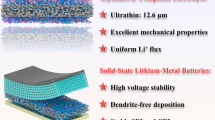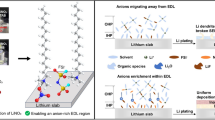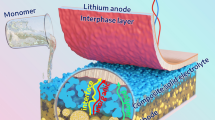Abstract
Liquid-phase syntheses of sulfide materials are attractive for the mass production of solid electrolytes for all-solid-state batteries. In liquid-phase synthesis, the precursor of the solid electrolyte is obtained. The precursors are important for producing electrolytes of the same quality because they decompose into electrolytes by heat treatment. However, only a few studies have focused on the formation mechanism and structure of precursors. This study proposes a formation mechanism for Li3PS4 during liquid-phase synthesis using ethylenediamine (EDA) as a solvent and clarifies the crystal structure of Li3PS4·NH2CH2CH2NH2 (Li3PS4·EDA). Raman spectroscopy and nuclear magnetic resonance revealed that intermediate P2S62− units were generated in the EDA solution. Crystal structure analysis of Li3PS4·EDA showed that the terminal nitrogen atom of EDA coordinates with two lithium atoms. Ionic conductivity of Li3PS4·EDA was 2.8 × 10−9 S cm−1 at 25 °C. The analysis of precursors of solid electrolytes provides insight into the behavior of solvent molecules as ligands in the synthesis of sulfide electrolytes.

Graphical abstract
Highlights
-
β-Li3PS4 is prepared using a precursor obtained from Li3PS4 and ethylenediamine.
-
Intermediate P2S62− units are generated in the ethylenediamine solution.
-
Tetrahedra of PS4 and LiS4 form a framework in the precursor.
-
Ethylenediamine molecules coordinate to two lithium cations in the precursor.





Similar content being viewed by others
References
Janek J, Zeier WG (2016) A solid future for battery development. Nat Energy 1:16141. https://doi.org/10.1038/nenergy.2016.141
Manthiram A, Yu X, Wang S (2017) Lithium battery chemistries enabled by solid-state electrolytes. Nat Rev Mater 2:16103. https://doi.org/10.1038/natrevmats.2016.103
Sakuda A, Hayashi A, Tatsumisago M (2013) Sulfide solid electrolyte with favorable mechanical property for all-solid-state lithium battery. Sci Rep 3:2–6. https://doi.org/10.1038/srep02261
Kimura T, Inoue A, Nagao K et al. (2022) Characteristics of a Li3BS3 thioborate glass electrolyte obtained via a mechanochemical process. ACS Appl Energy Mater 5:1421–1426. https://doi.org/10.1021/acsaem.1c02452
Hayashi A, Hama S, Morimoto H et al. (2001) High lithium ion conductivity of glass-ceramics derived from mechanically milled glassy powders. Chem Lett 30:872–873. https://doi.org/10.1246/cl.2001.872
Hayashi A, Hama S, Morimoto H et al. (2001) Preparation of Li2S-P2S5 amorphous solid electrolytes by mechanical milling. J Am Ceram Soc 84:477–479. https://doi.org/10.1111/j.1151-2916.2001.tb00685.x
Mizuno F, Hayashi A, Tadanaga K, Tatsumisago M (2005) New, highly ion-conductive crystals precipitated from Li 2S-P2S5 glasses. Adv Mater 17:918–921. https://doi.org/10.1002/adma.200401286
Tatsumisago M (2002) New lithium ion conducting glass-ceramics prepared from mechanochemical Li2S-P2S5 glasses. Solid State Ion 154–155:635–640. https://doi.org/10.1016/S0167-2738(02)00509-X
Hayashi A, Hama S, Minami T, Tatsumisago M (2003) Formation of superionic crystals from mechanically milled Li2S-P2S5 glasses. Electrochem Commun 5:111–114. https://doi.org/10.1016/S1388-2481(02)00555-6
Kanno R, Hata T, Kawamoto Y, Irie M (2000) Synthesis of a new lithium ionic conductor, thio-LISICON-lithium germanium sulfide system. Solid State Ion 130:97–104. https://doi.org/10.1016/S0167-2738(00)00277-0
Murayama M, Kanno R, Irie M (2002) Synthesis of new lithium ionic conductor thio-LISICON – lithium silicon sulfides system. J Solid State Chem 168:140–148. https://doi.org/10.1006/jssc.2002.9701
Murayama M, Kanno R, Kawamoto Y, Kamiyama T (2002) Structure of the thio-LISICON, Li4GeS4. Solid State Ion 154–155:789–794. https://doi.org/10.1016/S0167-2738(02)00492-7
Kanno R, Murayama M (2001) Lithium ionic conductor thio-LISICON: the Li2S-GeS2-P2S5 system. J Electrochem Soc 148:A742. https://doi.org/10.1149/1.1379028
Murayama M, Sonoyama N, Yamada A, Kanno R (2004) Material design of new lithium ionic conductor, thio-LISICON, in the Li2S-P2S5 system. Solid State Ion 170:173–180. https://doi.org/10.1016/j.ssi.2004.02.025
Homma K, Yonemura M, Kobayashi T et al. (2011) Crystal structure and phase transitions of the lithium ionic conductor Li3PS4. Solid State Ion 182:53–58. https://doi.org/10.1016/j.ssi.2010.10.001
Kimura T, Kato A, Hotehama C et al. (2019) Preparation and characterization of lithium ion conductive Li3SbS4 glass and glass-ceramic electrolytes. Solid State Ion 333:45–49. https://doi.org/10.1016/j.ssi.2019.01.017
Kimura T, Hotehama C, Sakuda A et al. (2021) Structures and conductivities of stable and metastable Li5GaS4 solid electrolytes. RSC Adv 11:25211–25216. https://doi.org/10.1039/D1RA03194E
Rao RP, Adams S (2011) Studies of lithium argyrodite solid electrolytes for all-solid-state batteries. Phys Status Solidi A 208:1804–1807. https://doi.org/10.1002/pssa.201001117
Kong ST, Gün O, Koch B et al. (2010) Structural characterisation of the Li argyrodites Li7PS6 and Li7PSe6 and their solid solutions: quantification of site preferences by MAS-NMR spectroscopy. Chemistry 16:5138–5147. https://doi.org/10.1002/chem.200903023
Rayavarapu PR, Sharma N, Peterson VK, Adams S (2012) Variation in structure and Li+-ion migration in argyrodite-type Li6PS5X (X = Cl, Br, I) solid electrolytes. J Solid State Electrochem 16:1807–1813. https://doi.org/10.1007/s10008-011-1572-8
Kraft MA, Ohno S, Zinkevich T et al. (2018) Inducing high ionic conductivity in the lithium superionic argyrodites Li6+xP1-xGexS5I for all-solid-state batteries. J Am Chem Soc 140:16330–16339. https://doi.org/10.1021/jacs.8b10282
Kamaya N, Homma K, Yamakawa Y et al. (2011) A lithium superionic conductor. Nat Mater 10:682–686. https://doi.org/10.1038/nmat3066
Kato Y, Hori S, Saito T et al. (2016) High-power all-solid-state batteries using sulfide superionic conductors. Nat Energy 1:16030. https://doi.org/10.1038/nenergy.2016.30
Miura A, Rosero-Navarro NC, Sakuda A et al. (2019) Liquid-phase syntheses of sulfide electrolytes for all-solid-state lithium battery. Nat Rev Chem 3:189–198. https://doi.org/10.1038/s41570-019-0078-2
Liu Z, Fu W, Payzant EA et al. (2013) Anomalous high ionic conductivity of nanoporous β-Li3PS4. J Am Chem Soc 135:975–978. https://doi.org/10.1021/ja3110895
Wang H, Hood ZD, Xia Y, Liang C (2016) Fabrication of ultrathin solid electrolyte membranes of β-Li3PS4 nanoflakes by evaporation-induced self-assembly for all-solid-state batteries. J Mater Chem A 4:8091–8096. https://doi.org/10.1039/C6TA02294D
Phuc NHH, Totani M, Morikawa K et al. (2016) Preparation of Li3PS4 solid electrolyte using ethyl acetate as synthetic medium. Solid State Ion 288:240–243. https://doi.org/10.1016/j.ssi.2015.11.032
Phuc NHH, Morikawa K, Mitsuhiro T et al. (2017) Synthesis of plate-like Li3PS4 solid electrolyte via liquid-phase shaking for all-solid-state lithium batteries. Ionics 23:2061–2067. https://doi.org/10.1007/s11581-017-2035-8
Choi S, Lee S, Park J et al. (2018) Facile synthesis of Li2 S-P2 S5 glass-ceramics electrolyte with micron range particles for all-solid-state batteries via a low-temperature solution technique (LTST). Appl Surf Sci 444:10–14. https://doi.org/10.1016/j.apsusc.2018.02.270
Phuc NHH, Morikawa K, Totani M et al. (2016) Chemical synthesis of Li3PS4 precursor suspension by liquid-phase shaking. Solid State Ion 285:2–5. https://doi.org/10.1016/j.ssi.2015.11.019
Teragawa S, Aso K, Tadanaga K et al. (2014) Liquid-phase synthesis of a Li3PS4 solid electrolyte using N-methylformamide for all-solid-state lithium batteries. J Mater Chem A 2:5095–5099. https://doi.org/10.1039/c3ta15090a
Ito A, Kimura T, Sakuda A et al. (2022) Liquid-phase synthesis of Li3PS4 solid electrolyte using ethylenediamine. J Sol Gel Sci Technol 101:2–7. https://doi.org/10.1007/s10971-021-05524-y
Calpa M, Rosero-Navarro NC, Miura A et al. (2020) Formation mechanism of thiophosphate anions in the liquid-phase synthesis of sulfide solid electrolytes using polar aprotic solvents. Chem Mater 32:9627–9632. https://doi.org/10.1021/acs.chemmater.0c03198
Delnick FM, Yang G, Self EC et al. (2020) Investigation of complex intermediates in solvent-mediated synthesis of thiophosphate solid-state electrolytes. J Phys Chem C 124:27396–27402. https://doi.org/10.1021/acs.jpcc.0c08761
Matsuda R, Hirahara E, Phuc NHH et al. (2018) Preparation of LiNi1/3Mn1/3Co1/3O2/Li3PS4 cathode composite particles using a new liquid-phase process and application to all-solid-state lithium batteries. J Ceram Soc Jpn 126:826–831. https://doi.org/10.2109/jcersj2.18080
Ito S, Nakakita M, Aihara Y et al. (2014) A synthesis of crystalline Li7P3S11 solid electrolyte from 1,2-dimethoxyethane solvent. J Power Sources 271:342–345. https://doi.org/10.1016/j.jpowsour.2014.08.024
Wang Y, Lu D, Bowden M et al. (2018) Mechanism of formation of Li7P3S11 solid electrolytes through liquid phase synthesis. Chem Mater 30:990–997. https://doi.org/10.1021/acs.chemmater.7b04842
Wang Z, Jiang Y, Wu J et al. (2020) Reaction mechanism of Li2S-P2S5 system in acetonitrile based on wet chemical synthesis of Li7P3S11 solid electrolyte. Chem Eng J 393:124706. https://doi.org/10.1016/j.cej.2020.124706
Calpa M, Nakajima H, Mori S et al. (2021) Formation mechanism of β-Li3PS4 through decomposition of complexes. Inorg Chem 60:6964–6970. https://doi.org/10.1021/acs.inorgchem.1c00294
Sedlmaier SJ, Indris S, Dietrich C et al. (2017) Li4PS4I:A Li+ superionic conductor synthesized by a solvent-based soft chemistry approach. Chem Mater 29:1830–1835. https://doi.org/10.1021/acs.chemmater.7b00013
Ozturk T, Ertas E, Mert O (2010) A berzelius reagent, phosphorus decasulfide (P4S10), in organic syntheses. Chem Rev 110:3419–3478. https://doi.org/10.1021/cr900243d
Boultif A, Louër D (2004) Powder pattern indexing with the dichotomy method. J Appl Crystallogr 37:724–731. https://doi.org/10.1107/S0021889804014876
Izumi F, Momma K (2007) Three-dimensional visualization in powder diffraction. Solid State Phenom 130:15–20. 10.4028/ww w.scientific.net/SSP.130.15
Momma K, Izumi F (2011) VESTA 3 for three-dimensional visualization of crystal, volumetric and morphology data. J Appl Crystallogr 44:1272–1276. https://doi.org/10.1107/S0021889811038970
Dietrich C, Weber DA, Culver S et al. (2017) Synthesis, structural characterization, and lithium ion conductivity of the lithium thiophosphate Li2P2S6. Inorg Chem 56:6681–6687. https://doi.org/10.1021/acs.inorgchem.7b00751
Dietrich C, Weber DA, Sedlmaier SJ et al. (2017) Lithium ion conductivity in Li2S-P2S5 glasses-building units and local structure evolution during the crystallization of superionic conductors Li3PS4, Li7P3S11 and Li4P2S7. J Mater Chem A 5:18111–18119. https://doi.org/10.1039/C7TA06067J
Eckert H, Zhang Z, Kennedy JH (1990) Structural transformation of non-oxide chalcogenide glasses. The short-range order of lithium sulfide (Li2S)-phosphorus pentasulfide (P2S5) glasses studied by quantitative phosphorus-31, lithium-6, and lithium-7 high-resolution solid-state NMR. Chem Mater 2:273–279. https://doi.org/10.1021/cm00009a017
Pasha I, Choudhury A, Rao CNR (2003) An organically templated open-framework cadmium selenite. Solid State Sci 5:257–262. https://doi.org/10.1016/S1293-2558(02)00100-0
Wang Y, Yu J, Shi Z, Xu R (2003) Synthesis and characterization of a new layered gallium phosphate [Co(en)3][Ga3(H2PO4) 6(HPO4)3] templated by cobalt complex. J Solid State Chem 170:176–181. https://doi.org/10.1016/S0022-4596(02)00060-9
Liu Y, Pan R, Cheng JW et al. (2015) A series of Aluminoborates templated or supported by zinc-amine complexes. Chemistry 21:15732–15739. https://doi.org/10.1002/chem.201501420
Nakatsu K, Saito Y, Kuroya H (1956) Studies on crystals of metallic Tris-ethylenediamine-complexes. I. The crystal structure of DL-Tris-ethylenediamine-cobalt (III) chloride trihydrate, [Co en3]Cl3 3H2O’. Bull Chem Soc Jpn 29:428–434. https://doi.org/10.1246/bcsj.29.428
Börtin O, Niklewski T, Nygren M et al. (1976) On the crystal structures of cis- and trans-bis(ethylenediamine)dinitrocobalt(III) nitrate. Acta Chem Scand 30a:657–660. https://doi.org/10.3891/acta.chem.scand.30a-0657
Funding
This work was supported by JSPS KAKENHI (Grant number 18H05255).
Author information
Authors and Affiliations
Contributions
TK and AI carried out the synthesis, XRD measurement, Raman spectroscopy, and thermal analysis. TN and HK performed NMR. TK and CH conducted crystal structure analysis. AS, MT, and AH supervised the research. TK wrote the manuscript and all authors commented on previous versions of the manuscript. All authors read and approved the final manuscript.
Corresponding author
Ethics declarations
Conflict of interest
The authors declare no competing interests.
Additional information
Publisher’s note Springer Nature remains neutral with regard to jurisdictional claims in published maps and institutional affiliations.
Rights and permissions
About this article
Cite this article
Kimura, T., Ito, A., Nakano, T. et al. Crystalline precursor derived from Li3PS4 and ethylenediamine for ionic conductors. J Sol-Gel Sci Technol 104, 627–634 (2022). https://doi.org/10.1007/s10971-022-05824-x
Received:
Accepted:
Published:
Issue Date:
DOI: https://doi.org/10.1007/s10971-022-05824-x




